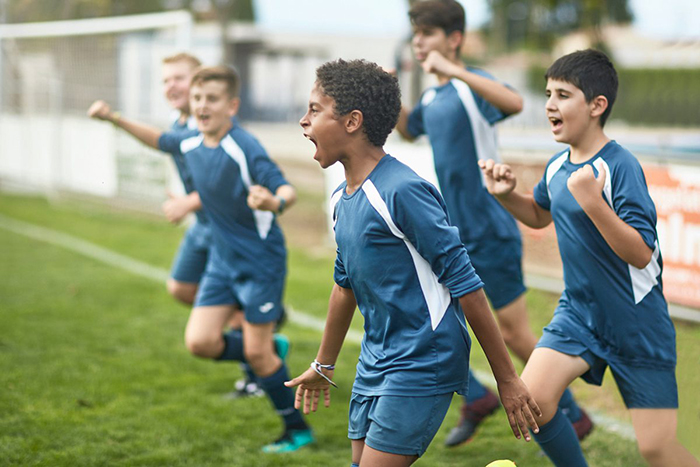The foundation of these components is knowing in which developmental stage your youth athlete exists.
“Where your child is in terms of age and growth should really drive the decisions and guidelines you put into practice when it comes to playing and training for sports,” Dr. Jayanthi states. “A high school athlete who is finished growing is much more capable than adolescents in the middle of their growth spurts. Adolescents, likewise, are at a very different skill level than young children.”
Parents and coaches can use three different developmental stages to help them decide which activities are best – and safest – for their child. Those three stages include:
- Preadolescence: Children are typically in the preadolescent phase before they go through puberty or their adolescent growth spurt. This largely depends on the individual child, but typically lasts until early middle school for girls and late middle school for boys.
- Adolescent growth spurt: The second phase occurs when your child is going through a growth spurt. This time period can vary widely but typically starts around age 11 for girls and age 13 for boys. It lasts about two years.
- Late adolescence: The final developmental stage occurs once children have nearly reached their expected height and are finished with most of their growth.
Athletes in each of these categories should follow specific recommendations and advice on how and when they train. Dr. Jayanthi breaks down each category and what parents – and coaches – should expect.
Preadolescent Athletes
“The youngest kids should be focused on playing for fun.” Dr. Jayanthi encourages.
“Sports and physical activity are an amazing way to get even the youngest kids moving, having fun and developing coordination, social skills and showing how enjoyable it is to be active,” he says.
He has extensively researched some simple rules in youth athletes and recommends parents and coaches follow these guidelines to keep young kids safe, healthy and happy while playing sports:
- Avoid specializing in one sport. Playing different sports introduces kids to a variety of possible interests and helps reduce the risk of overuse injuries.
- Train less hours per week than a child’s age. If your child is eight years old, your child should not be participating in organized sports (including practice and games) for more than eight hours a week. When kids start to play many different sports, that time can quickly add up. Monitoring training load can help avoid injuries.
- Focus on fun. Young kids should be focused on playing for fun, not competition. When a young child plays too intensely (or in too many games, competitions or tournaments), they are more likely to become injured and burned out.
- Encourage free play. Free play is a wonderful way for children to improve their motor control. Running, jumping, skipping, and playing outside with friends will boost coordination, bolster imagination and show kids how fun it is to play outside.
Adolescent Athletes
“Athletes who are going through periods of rapid growth (during their growth spurts) are more likely to develop growth-related overuse injuries,” says Dr. Jayanthi.
Help reduce your youth athlete’s risk of injury with these tips:
- Play multiple sports. It can be tempting for kids to start specializing in sports at a young age but playing different sports throughout the year helps kids become better all-around athletes and reduces their risk of overuse injuries.
- Keep training hours each week less than their age. Growing athletes (and parents) still need to be mindful about how much they’re playing. Make sure your athlete isn’t playing in practice, games, or competition more hours a week than their age.
- Play for fun. Children developing their athletic abilities (and their growing bodies) should still avoid participating in too many competitions or intense training sessions. “It’s okay to introduce competition at this age,” reassures Dr. Jayanthi. “Just be sure the focus is still playing for fun.”
- Build coordination. Growth spurts are often a time of “adolescent awkwardness.” Playing different sports or even working with a certified trainer to build strength can help improve coordination and specific skills. This focus can also help reduce the risk of injury.
Late Adolescent Athletes
Athletes who have finished most of their growth (typically in high school) can safely start introducing more intensity to their play. That’s because their bodies are reaching their skeletal maturity and are better equipped to play harder and less likely to get injured.
Here are Dr. Jayanthi’s tips to keeping your competitive youth athlete safe:
- It’s okay to specialize. When your child is nearly finished growing and interested in developing skills in one specific sport, it’s okay to start specializing in one sport if it is the child’s decision.
- It’s safe to increase workload. Once athletes get past their growth spurts in high school and college, it may be possible to increase beyond the hours per week per age rule in certain resilient athletes and sports. However, following time off (or injury), they should return to higher workloads slowly at <25% increase from week to week.
- Competition becomes a priority. Older athletes begin to play to win instead of playing for fun. As long as your athletes and coaches are guiding those expectations reasonably and safely, it’s okay to start competing in more tournaments and games.
- Well-rounded training improves motor control. Workouts off the field – like weightlifting, cross-training, and warm-up programs – will help improve coordination and skills for players of any games.
Guiding Your Athlete to Success
No matter your child’s ability or interest, there are safe ways to foster a love of sports. If you have a question about your child’s sports involvement, talk to your child’s provider or contact the Emory Orthopaedics Youth Sports Medicine program.
Our team works together to design age-appropriate, individualized treatment plans that help young athletes get back in the game as quickly and safely as possible. We have the only program in the entire region that cares for multiple professional and college teams with the same physicians and experts who care for your young athlete. Call 404-778-3350 to schedule an appointment with a youth sports medicine physician near you.




